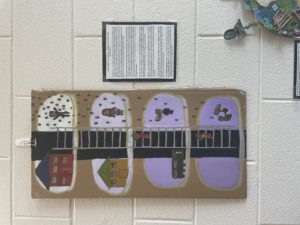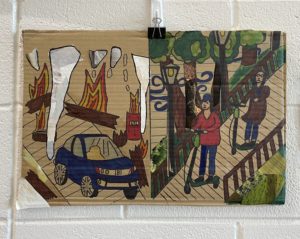
The hallways of the A-building have been recently adorned with student artwork and accompanying analysis for a project called “I Will Change the World.”
This project is a part of a 50-year-old National Parent Teacher Association (PTSA) program called Reflections. Each year a different theme is chosen, and over 300,000 students around the United States participate.
This is the second year mixed-media teacher Paul Estrada has included Reflections in his curriculum.
“I wanted our first project to be one that allowed students to really express themselves,” Estrada said, “while also providing me with an opportunity to assess where my students are.”
Estrada shared that the local PTSA was a “great help” in hanging the student artwork around the hallway.
Students’ projects focused on issues like racism, sexism, homophobia, wealth inequality, civil rights and climate change.

Sophomore Erica Boatwright shared that students were given significant artistic freedom on what they wanted to center their project around and what materials they would use to do so.
“I did something really different compared to what I usually do with art, and I probably would not have tried collage if it was not for this project,” Boatwright said.
Boatwright’s project used old instrument strings, newspaper, compact discs and magazine cutouts to express her vision about the intertwining of popular culture and nature.
“My piece was made to show that I think nature and technology and modern-day advances should intertwine to make a better world instead of how [technology is] destroying nature,” Boatwright said.

Freshman Rachel Penzner created a piece that depicts the wealth gap and how those at the top of the economic ladder have more access to money and resources than those on the bottom who struggle to make ends meet.
“I was thinking about the wealth gap and how it just keeps getting wider and wider, making it difficult for poor people to get to the top because the rich people are taking all the money and resources,” Penzner said.

Freshman Mary Mestas’s project was a collage called I will change the world by asking questions. She utilized newspaper, magazine clippings, old file folders and three-dimensional objects made from cardboard.
Mestas said that the project encouraged her to step outside of her comfort zone and create a creative project from a simple prompt.
“I was able to learn about my own creative process and how to stretch an idea out of the circle of what is most direct or simple,” Mestas said.

Sophomore Brention Lowery used paint and cardboard to create a three-dimensional display of the harmful effects of toxic waste on fish and their ecosystems.
“My focus was to show the disregard and the negligence of the human population towards the Earth and the impact of global warming,” Lowery said.

Freshman Bowie Rankow used recycled cardboard, markers and some magazine cutouts to depict how cars influence climate change and how it would be beneficial to switch to electric cars.
“Personally I became alarmed about what an effect this issue has,” Rankow said, “but, from an artistic perspective, I learned how great recycled materials are to work with!”
Estrada said he appreciated that students were able to express themselves individually through material, theme and artistic style.
“If I do my job right as an art teacher, all these projects should look different from one another,” he said.











